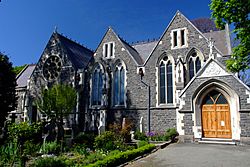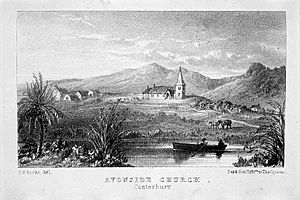Holy Trinity Avonside facts for kids
Quick facts for kids Holy Trinity Avonside |
|
|---|---|

Holy Trinity Avonside in 2008, prior to its 2011 demolition
|
|
| 43°31′36″S 172°39′31″E / 43.5266°S 172.6586°E | |
| Location | Linwood, Christchurch |
| Country | New Zealand |
| Previous denomination | Anglican |
| History | |
| Status | Church (former) |
| Consecrated | 1857 |
| Events | 2011 Christchurch earthquake |
| Architecture | |
| Functional status | Demolished |
| Heritage designation | Category I |
| Designated | 16 November 1989 |
| Architectural type | Gothic Revival style |
| Closed | February 2011 |
| Demolished | September 2011 |
Holy Trinity Avonside was an old Anglican church located in Linwood, Christchurch, New Zealand. It was a very special building, listed as a "Historic Place – Category I" by the New Zealand Historic Places Trust. This means it was considered very important to the country's history. Sadly, the church building was "damaged beyond the point of repair" in the big 2011 Christchurch earthquake in February 2011. It was taken down in September of that same year.
Contents
The Story of Holy Trinity Avonside
The church's story began in 1855 when the Holy Trinity Avonside Parish was created. The very first church service was held in the home of Rev. Charles Mackie. The first actual church building was ready for Christmas Day in 1855. It was designed by Charles Edward Fooks and built from a material called cob, which is like a mix of clay, sand, straw, and water.
This first church was officially dedicated on 24 February 1857. It was the first Anglican church in Canterbury to be dedicated by Bishop Harper. The land for the church was given by John and Elizabeth Stace, who had arrived in New Zealand in 1851.
A local architect named Benjamin Mountfort, who was also a member of the church, designed new parts for the building. In 1869, he added a bell tower and a wooden vestry (a room used by clergy). Around 1873, more additions designed by Mountfort included a stone chancel (the area around the altar) and transepts (parts of the church that cross the main body).
In 1905, the original cob building was replaced with a stone nave (the main part of the church where people sit). This new part was designed by Mountfort's son, Cyril Mountfort. Later, in 1953–1954, the west end of the church was made longer. This meant the very oldest parts of the building (from before 1870) were removed.
Earthquake Damage and Demolition
The church was first damaged in the 2010 Canterbury earthquake. While repairs were being done, the much stronger February 2011 Christchurch earthquake hit. This earthquake caused huge damage to the church. The chancel and most of the transepts collapsed. The church was so badly damaged that it could not be fixed.
Workers who were repairing the church were having lunch outside when the 1876 part of the building collapsed. Luckily, no one was hurt. The church was taken down in September 2011. This decision caused a lot of discussion. Some people who cared about old buildings felt that the church was even more important than ChristChurch Cathedral. They believed more should have been done to save it. They thought it should have been taken apart carefully to save important parts like the ceilings. Instead, diggers quickly broke everything down.
However, Bishop Victoria Matthews explained why the church had to be demolished. She said her main concern was the safety of people. She felt it was not safe to take chances with a building that could collapse. A special time capsule, which held the words from the church's dedication, was found safely underneath the nave.
The Church Graveyard
The church had a graveyard where many important people from Canterbury were buried. Here are some of them:
- Joseph Brittan (1805–1867), a surgeon, newspaper editor, and local politician.
- James Arthur Flesher (1865–1930), who was the Mayor of Christchurch.
- Julius von Haast (1822–1887), a famous explorer and geologist.
- Cyril Mountfort (1852–1920), an architect, who was Benjamin Mountfort's son.
- Benjamin Mountfort (1825–1898), a well-known architect who designed parts of the church.
- William Rolleston (1831–1903), a leader of the Canterbury Province.
- George Warren Russell (1854–1937), who was the Minister of Health during the 1918 flu pandemic.
There is also one Commonwealth war grave in the graveyard. This is for a New Zealand soldier who died in World War I.
Why it was a Heritage Site
On 16 November 1989, Holy Trinity Avonside Church was officially listed as a Category I historic place by the New Zealand Historic Places Trust. Its special registration number was 3113.
The church was important for several reasons. Among all the churches designed by Benjamin Mountfort, this one was special because it was his first Anglican church built from stone. The graveyard was also very significant because so many important historical figures were buried there. Also, the church's parish was one of the very first to be set up in Christchurch.



